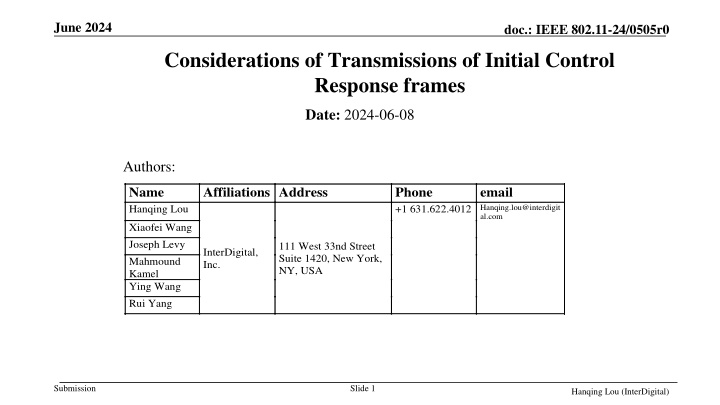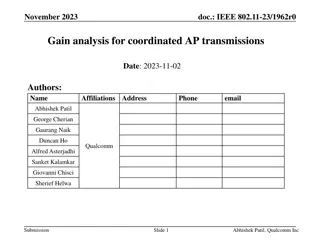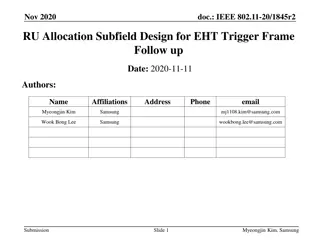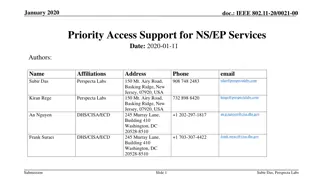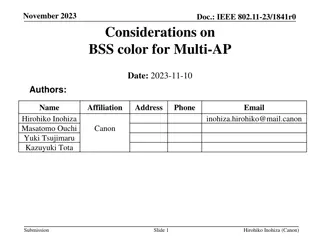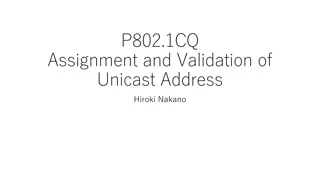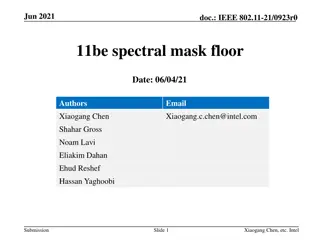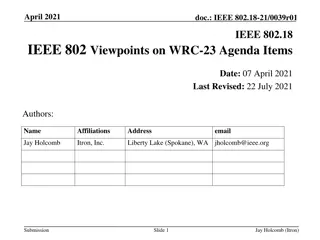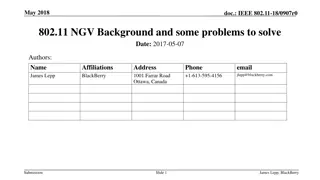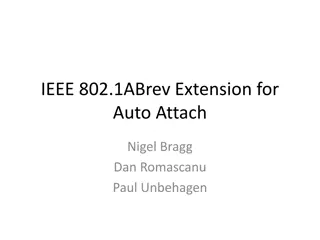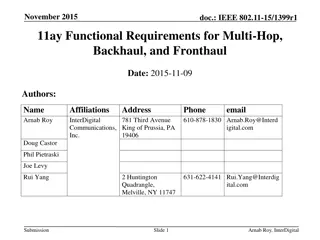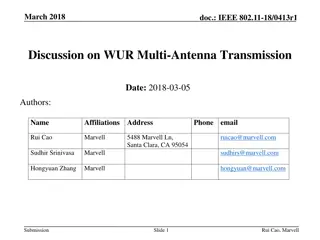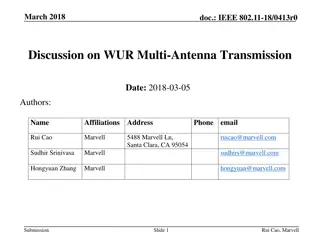Considerations for IEEE 802.11 Transmissions
This document delves into the considerations of transmissions of initial control response frames in IEEE 802.11 standards. It reviews procedures like NPCA, DSO, power saving, coexistence, and dynamic preamble puncturing, proposing a unified design for dynamic mode changes. The author discusses the design considerations for ICF and ICR frames and explores various options of what should be included in the ICR frames. The transmission scenarios of ICF and ICR frames in different modes are also assessed in detail.
Download Presentation

Please find below an Image/Link to download the presentation.
The content on the website is provided AS IS for your information and personal use only. It may not be sold, licensed, or shared on other websites without obtaining consent from the author.If you encounter any issues during the download, it is possible that the publisher has removed the file from their server.
You are allowed to download the files provided on this website for personal or commercial use, subject to the condition that they are used lawfully. All files are the property of their respective owners.
The content on the website is provided AS IS for your information and personal use only. It may not be sold, licensed, or shared on other websites without obtaining consent from the author.
E N D
Presentation Transcript
June 2024 doc.: IEEE 802.11-24/0505r0 Considerations of Transmissions of Initial Control Response frames Date: 2024-06-08 Authors: Name Hanqing Lou Affiliations Address Phone +1 631.622.4012 Hanqing.lou@interdigit email al.com Xiaofei Wang Joseph Levy Mahmound Kamel Ying Wang Rui Yang 111 West 33nd Street Suite 1420, New York, NY, USA InterDigital, Inc. Submission Slide 1 Hanqing Lou (InterDigital)
June 2024 doc.: IEEE 802.11-24/0505r0 Recap In [1], we reviewed NPCA, DSO, Power saving, in-device coexistence and dynamic preamble puncturing procedures, and considered them as changes between different modes. Although they are different procedures to achieve different purposes, they share some commonalities. A unified design of initial control frames for dynamic mode changes is proposed. Submission Slide 2 Hanqing Lou (InterDigital)
June 2024 doc.: IEEE 802.11-24/0505r0 Recap: General Design Considerations for ICF [1] Power Saving Dynamic Puncturing ICF NPCA DSO Coexistence Highlighed Design Consideration No Yes Yes Yes No Transmitted before Mode Change Yes Maybe Maybe Yes Yes ICF/ICR in the same Mode Padding (e.g., FCS2) If with diff modes, padding is needed No Yes Yes No No To support lagecy NAV setting, better to use non-HT Dup PPDU Maybe Maybe Maybe Maybe Maybe Carried in non-HT Dup PPDU Support multicast transmission (one-to- multiple) Yes Yes Yes Maybe Yes Could reuse TF. Need to design whether ICR is carried in TB PPDU Yes Yes Yes Yes Yes Initiated by an AP TF is DL only now. Either using TF with modification or a new type, or a new frame. Yes No Maybe Yes Yes Initiated by a non AP STA Contains Max BW Contains Max Tx/Rx Nss Contains Max MCS/Rx MCS Contains Dynamic puncturing Contains unavailable time Contains QoS Maybe Maybe Maybe Maybe No Maybe Maybe Maybe Maybe Maybe No Maybe Yes Yes Yes Yes Yes Yes Yes Yes Maybe Maybe Maybe Yes No Maybe With unified design, we could define different types/variants for different use cases/scenarios Maybe No Maybe Maybe Good to have in all cases Submission Slide 3 Hanqing Lou (InterDigital)
June 2024 doc.: IEEE 802.11-24/0505r0 What Should Be Carried in ICR? Option 1: ICR serves as an acknowledgement of ICF. The transmission of ICR is an implicit indication that the STA accepts the proposed dynamic mode change. In some scenarios, ICRs are concurrently transmitted in UL by multiple STAs. A natural question would be whether an ICR carries STA specific information, or it is designed to be identical from different STAs. Option 2: ICR is used to accept or reject the proposed dynamic mode change by ICF. Status code may be included in the ICR so that it could explicitly indicate whether it accepts or rejects the proposed dynamic mode change and the reason to reject. Option 3: ICR carries operational parameters proposed by the TXOP responder. The operational parameters carried in the ICR may be limited by the parameters proposed by the ICF. For example, a maximum bandwidth carried in the ICR may be upper bounded by the maximum bandwidth carried in the ICF. Different options may be used for different types of ICFs that solicited the ICR frames. Submission Slide 4 Hanqing Lou (InterDigital)
June 2024 doc.: IEEE 802.11-24/0505r0 Transmission of ICF and ICR ICF Data ICF Data ICF Data ICR ACK ICR ACK ICR ACK Mode 1 Mode 1 Mode 1 Mode 2 Mode 1 Mode 2 Mode 1 Switch points Switch points Switch points Mode 1 could be considered as a permanent/static mode and Mode 2 could be considered as a transient/dynamic mode. Option 1: An ICF is transmitted in Mode 1 and an ICR is transmitted in Mode 2. Padding is needed in ICF. Exemplary usage cases include power saving, DSO, etc. Option 2: both ICF and ICR are transmitted in Mode 1. Padding may be needed in the ICR. Exemplary usage cases include coexistence, DSO, etc. Option 3: both ICF and ICR are transmitted in Mode 2. Exemplary usage cases include NPCA, dynamic preamble puncturing, etc. It may be more flexible if we allow different ICF/ICR transmission options for the same usage case with different STA capabilities. For example, we could use option 1 or option 2 for DSO STAs with different center frequency switching delay capabilities. Submission Slide 5 Hanqing Lou (InterDigital)
June 2024 doc.: IEEE 802.11-24/0505r0 Summary We reviewed what kind of information should be carried in the ICR. Three different options to transmit ICF/ICR are discussed. For ICR design, we propose to consider the following: The information carried by ICR depends on the Dynamic mode change types, e.g., NPCA, DSO, Power saving, in-device coexistence, dynamic preamble puncturing, etc. Flexible transmission mechanisms of ICF/ICR, e.g., transmitted before the mode change or after the mode change. Submission Slide 6 Hanqing Lou (InterDigital)
June 2024 doc.: IEEE 802.11-24/0505r0 Reference [1] 11-24-0504 Considerations of a unified initial control frame Submission Slide 7 Hanqing Lou (InterDigital)
